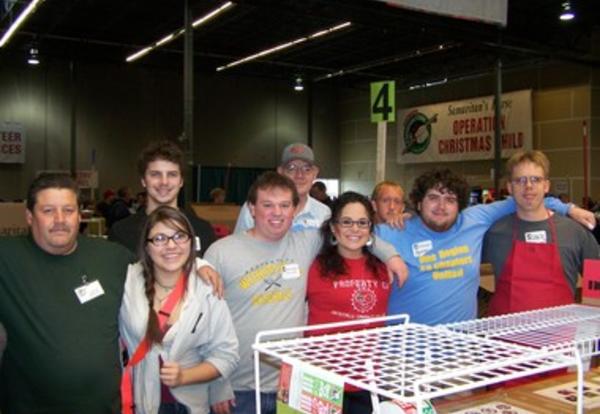
Phi Theta Kappa members at Coffeyville Community College experienced the holiday spirit early when they participated in a service project at the international processing center of Operation Christmas Child, a ministry of Samaritan’s Purse. The project was part of an educational field trip that took the CCC students to Denver November 23-27. In route to Colorado, the students adventured into the past with a visit to Fort Larned, the most complete fort surviving from the days of Custer and Buffalo Bill Cody. The fort was built in 1860 to provide protection to the Santa Fe Trail. After viewing an informational movie, the students took a tour guided by Celeste Davis of the National Park Service. The students visited the barracks, hospital, shops building, new and old commissaries, blockhouse, quartermaster storehouse, and company and commander officers’ quarters. Before departing, chapter members tried on several of the military uniforms. November 24, found the students working the first shift at the Operation Christmas Child Processing Center in Denver. When they arrived, over 90,000 shoe boxes were waiting to be processed before delivery to children in Mexico and Haiti. The students also presented thirty-six filled shoe boxes from the chapter and Coffeyville community. The Coffeyville students joined 65,000 volunteers serving at processing centers in Atlanta, Boone and Charlotte, North Carolina, Denver, Honolulu, Minneapolis, and Orange County, California. The student’s main job was to check each shoe box for items that were not acceptable for shipping. At day’s end, a truck was loaded and on its way to Mexico. A representative from the Denver Post interviewed and filmed the Eta Gamma students for a feature story. On their way to Silver Thorn and their Timber Ridge lodging, students stopped at Idaho Springs and the Argo Gold Mine and Mill, a national historic site. The students spent Thanksgiving Day snowboarding and skiing at the Loveland Basin and later enjoyed a traditional dinner. On November 26, the group departed for Georgetown, the “Silver Queen of the Rockies”. Founded in 1859, Georgetown grew from a small mining camp tucked in a scenic valley into Colorado’s first great silver mining town and its third most populated city by the 1880’s. This rich legacy graced Georgetown with more than 200 historic Victorian buildings that were protected by the famous Georgetown Firehouse of which three remain. As a result, Georgetown was designated as part of a national Historic Landmark District and was named one of the twelve most distinctive destinations in the United States by the National Trust for Historic Preservation. While in Georgetown, the students witnessed the ingenuity of the engineers who built the most complex railroad in the world. Following lunch, the Phi Theta Kappans returned to Denver for a 3:00 p.m. tour of the Molly Brown House Museum. Historic Denver saved the fourteen room home from the wrecking ball and today this house museum is one of the country’s premier historic sites dedicated to women’s history. Concluding the tour was a film that was a chronicle of Molly’s life from her birth in Hannibal, Missouri to her heroism on the Titanic and finally, her work in the women’s suffrage movement. In route home, the students stopped in Nicodemus, an African American Home on the Frontier in northwestern Kansas. Founded in 1877, it was the first western town built by and for black settlers. For black farmers in the region, it was the economic and cultural hub for many decades. At the 1939 Township Hall, the students viewed several films on the history of Nicodemus and had a presentation form the National Park Service. Students participating in the Operation Christmas Child Field Trip were: Jeremy Willard, Zachary Hershey, Andrea Hamersky, Jacob Asbridge, Brianna Cordova, Tristan Zovala, and Michael Frazier.

